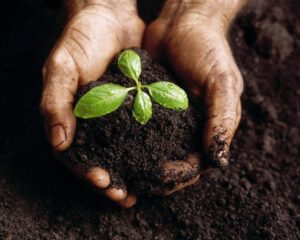Have you ever walked by a garbage can filled with rotten food, an old diaper, or worst of all – meat or seafood scraps? Catch a whiff of the stench and it’s enough to gag you. It’s like the microbes and dirty bacteria sticks to your nostrils and you can smell it even when you’re out of the vicinity (yuck!). Luckily, there’s a better place for your food scraps – in a compost pile. We can help by showing you how to compost…and keep your cans clean!
The truth is, stinky cans are more than just an annoyance for the person with a sensitive shnozz. It leaves you with an icky feeling every time you have to take the trash out. Can anyone say…wash your hands?
Most of the nasty trash can stench that lingers long after the garbage truck hauls it away is because of liquids. The less wet and rotting-prone scraps you throw into the can, the fewer liquids there are to stick around.
The answer? Compost. Composting is an excellent way to reduce trash odors and is a great way to make nutrient rich fertilizer for your plants or garden (for free!).
Let’s take a closer look at why composting is such a good idea.
How to Compost: It’s Good for the Earth and Keeps Your Cans Clean
Composting is the natural process of recycling dead organic matter and returning those nutrients to the soil, which you can then use for gardening or planting.
Plants that grow from composted soil have a higher tolerance against pests and diseases, giving richer harvests and healthier foliage. Soil mixed with compost is also better for retaining moisture, which means you can save money on your water bill.
You will also save on buying manure or other soil conditioners. Best of all, you’re using scraps that were going to be tossed into the garbage anyway!
Repurposing your trash can be a valuable tool to help educate children about the cycle of life. At the same time, it’s good for the Earth too. Did you know 1/3 of landfills is composed of food scraps and yard trimmings? Help divert unnecessary waste and reduce your carbon footprint. Future generations will thank you.
Learning how to compost is also very easy and only requires a few things you probably already have.
Here are step-by-step instructions on how to start composting.
Here Are the Basics on How to Compost
The first thing you’ll need is to find a container. The purpose of the bin is just to hold all the decomposing matter together so it doesn’t need to be elaborate. If you’re simply using a rubber trash can, make sure to drill some holes in it so the compost has room to breathe.
Next, pick a place in your yard for the pile. The best spots have a good combination of heat and moisture. This means if you place it in the direct sun, you may need to regularly sprinkle your pile with water. However, beware of overwatering as this can lead to rotting.
Tip: Your compost pile should have the consistency of a damp sponge.
Overall, successful composting requires 4 main ingredients:
- Brown Matter – Includes dead leaves, branches, twigs, wood chips, or even shredded newspaper
- Green Matter – Consists of kitchen scraps (fruits, vegetables, eggshells, coffee grounds), plant clippings and grass
- Water – As mentioned, having the correct amount of water is an important ingredient for compost. Too little, and the healthy bacteria will die but too much will cause the pile to rot.
- Air – Air is the 4th required ingredient for making quality compost. This means you should rotate your pile about once every week or so to give it the oxygen it needs.
As you can see, the basics of composting are easy and have many benefits. Not only will it help you save money, but keeps your garbage can cleaner too! You can learn more about composting from the EPA here.
If you’re still dealing with unsavory trash can smells, we can help! Clean Cans offers affordable trash can cleaning services that sanitize and keep your cans stench-free all year long!

